Using ginseng in herbal medicine
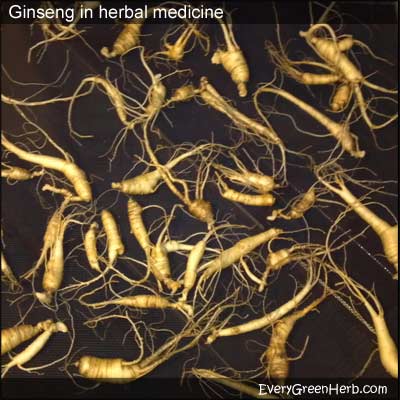
There are two main types of ginseng - American (Panax quinquefolius) and Asian or Korean ginseng (Panax ginseng). They are closely related.
Siberian ginseng is a different plant with different properties, and is not included in this post. We will save it for another day.
Regular use of ginseng builds immunity naturally, increases sperm count in men, and increases fertility in women. Studies show that ginseng is beneficial for both males and females.
Ginseng brings strength and stamina to men. In women, ginseng promotes healthy ovaries during child bearing years, and prevents thinning of the vaginal walls during menopause. These are just a few examples of what ginseng is known to do.
Ginseng roots improve immunity and more.
Ginseng roots contain hormone like substances that strengthen the immune system, fight stress, protect the liver, prevent memory loss, relieve hot flashes, enhance sexual desire, ease difficult childbirth, regulate blood sugar levels, lower cholesterol levels, and protect against cancer.
Ginseng makes a wonderful herbal tonic.
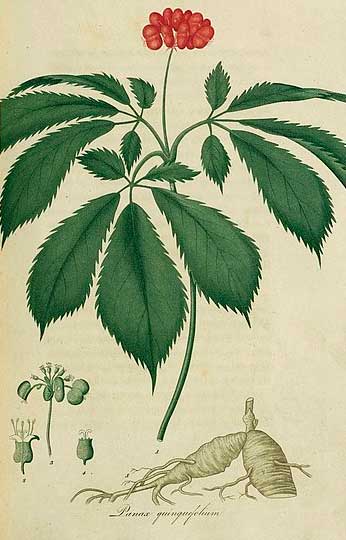
Regular use of ginseng helps protect the spleen and lungs. Ginseng use also raises energy levels, can help stop internal bleeding, and is a remedy for diarrhea.
For treating asthma and cough, combine ginseng with ginger.
For treating chronic cough or weak lungs, combine ginseng with mulberry bark.
For treating gastric ulcer pain, combine ginseng with slippery elm.
Ginseng is proven effective.
Ginseng is valuable because it works! It has a 2000 year history of use in herbal medicine, and modern day scientific studies show that ginseng is an effective medicine.
Ginseng contains a variety of ginsenosides (or ginseng saponins). These sugar like molecules work to heal and protect our bodies.
Different saponins work on different areas. One might help regulate blood sugar, while another might stimulate the immune system.

Human trials show conclusive evidence that both American and Asian (or Korean) ginseng stimulate immunity, reduce the risks of cancer, and improve brain function.
Ginseng also contains valuable essential oils, antioxidants, peptides, amino acids, vitamins, and more. These amazing substances can help heal many kinds of health problems.
Ginseng is an adaptogenic herb and its benefits are cumulative.
Ginseng is considered a powerful, adaptogenic herb. It has properties that treat a broad spectrum of diseases.
Benefits from using ginseng build up over time. Taking the herb for several months to a year (with weekly breaks every two months) is much more effective than short term doses.
Ginseng is a valuable root.
Ginseng is one of the most valuable plants on the planet. In some countries is it widely available in tincture form at herbal markets.
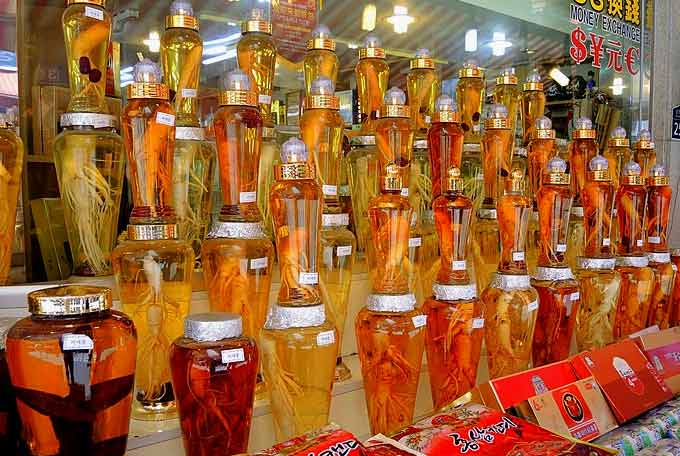
Ginseng can raise blood pressure in some people.
Ginseng is sometimes used in the treatment of cardiovascular disorders and is considered a heart tonic although it can raise blood pressure in some people.
It also has a therapeutic effect on recurrent viral infections like HIV.
Regular use of ginseng protects against toxins.
Protect against radiation, heavy metals, and air pollution by taking ginseng regularly. Use dried ginseng in tea, or chew the fresh root. It may also be chopped and added to honey. This is good on toast.
Ginseng protects skin from free radical damage.
One of the most promising uses of ginseng is its normalizing effects on skin cancer cells. As the world’s ozone layer thins, exposing the population to harmful UV rays, ginseng offers much needed protection.
Ginseng helps guard against aging skin and early wrinkling.
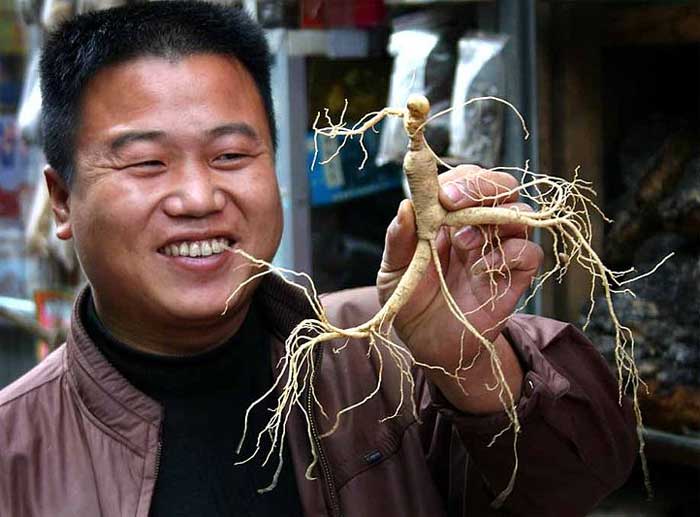
Ginseng is used in the treatment of depression, Alzheimer's, and liver cancer.
Ginseng offers long term mental and psychological benefits. It is good for depression, assists the memory process, improves concentration, and brings about alertness. It is often used in the treatment of Alzheimer’s.
Ginseng is also known to inhibit the growth of liver cancer cells (one of the most difficult cancers to overcome).
Fresh roots may be chewed.
Ginseng roots may be chewed when they are tender and fresh. They are very bitter, but Tony and I have developed a taste for them.
Since wild-harvested ginseng root is so sought after and becoming harder to find, it has become very expensive. Farm-grown ginseng can be purchased at much lower prices but is not considered as potent.
Ginseng may also be purchased as a tincture and in capsules.
What is the difference between wild harvest ginseng and shade grown ginseng?
You can easily tell the difference between farm grown and wild harvested ginseng.
Wild ginseng is knobby and branched because it is growing in the forest floor, around lots of tree roots and rocks. The root has to struggle a bit to take hold and grow.
Wild ginseng prefers lots of shade. The trees not only provide shade, they also drop leaves every fall. These conditions are not easy to duplicate on a farm.
Farm grown or shade grown ginseng is much straighter and uniform looking because it is usually grown on farms or homesteads in fields with shade cloth for protection from the sun. The good thing about shade grown ginseng is that it is affordable.
We have ordered it from Wisconsin and one thing is for sure. It is a lot better than doing without. Sometimes a small piece of ginseng is all it takes to bring energy to the mind and body.
Shade grown ginseng has wonderful health benefits, but get the wild if you can.
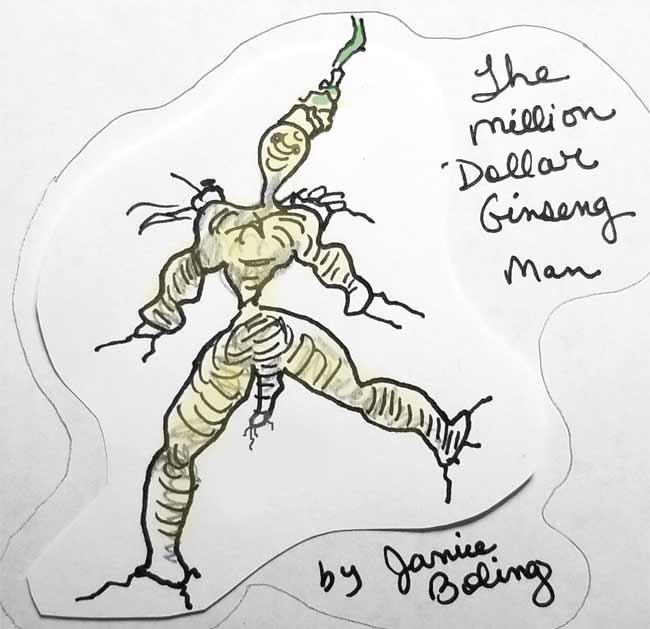
Appalachian wild ginseng is the most potent.
Wild ginseng of the Appalachian region (North Georgia and the Chattahoochee National Forest included) is the most highly-valued ginseng in the world. Due to heavy harvesting, the wild ginseng plant is becoming rare, and permits are required for gathering the roots in most states.
Also, buyers in China are keeping the prices at a premium. Ginseng is highly valued by the Chinese, with large, human-shaped roots going for millions of dollars.
Large roots with many branches are highly sought after. The most expensive ginseng roots resemble a human body with arms, legs, and other body parts.
The ginseng market in 2023
In 2021, most dried ginseng roots were selling for around $825 a pound depending on size and shape. Prices steadily went up and up every year until 2022, when the bottom seemed to drop dramatically.
According to the Imperial Ginseng Company, "Over 90% of North American ginseng production is exported with approximately 86% currently being imported to or through Hong Kong. The root is typically shipped from Hong Kong to the rest of China where it is graded and resold. China is the single largest ginseng consumer in the world."
I have heard that the Asians have quit buying top American wild ginseng, in order to push prices down. Now, in October 2023, fresh wild ginseng can be purchased for less than $300 per pound, with average dried roots going for around $400.
Nice big roots with lots of rings can still bring high prices.
We will see what happens next, only time will tell. I would love to see Americans consuming more ginseng. Why send our best resources out of the country? I know it's all about money, and it makes me sad. If Americans would consume more ginseng, then we would all be healthier and stronger!
Find more information about harvesting or selling ginseng in Georgia at Georgia Ginseng Management Program.
Ginseng grows in the woods and forests.
Ginseng grows best in temperate forests. It can also be grown in a stimulated “wild” environment with artificial shade.
Ginseng’s biggest pest is the poacher. When starting a ginseng bed, pick a site that can be monitored regularly.
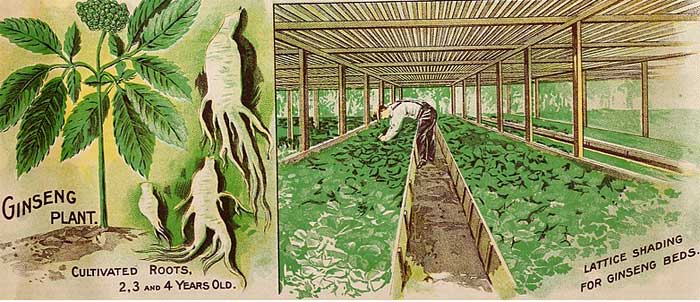
Ginseng doesn't like to be crowded while growing.
Do not crowd ginseng plants. They must have plenty of air circulation around their leaves. GInseng also requires rich soil with lots of leaf matter. One plant per square foot ensures maximum growth. Plant seeds in autumn when tree leaves start to fall and expect to wait four to five years for the first harvest.
*After using ginseng regularly for a couple of months, discontinue use for two weeks. Do not use ginseng with caffeine. People with high blood pressure should not use ginseng. Do not use ginseng during pregnancy.
Always consult with a healthcare professional before using any herbal remedy especially if pregnant, nursing, or taking other medications.
Sources:
https://www.ncbi.nlm.nih.gov/books/NBK92776/
https://www.sciencedirect.com/science/article/pii/S0753332220310258
https://www.mountsinai.org/health-library/herb/american-ginseng
https://www.imperialginseng.com/about_ginseng/industry_background.htm
Blessings to you and yours!
Thanks so much for reading my blog. Jan.

*Note - the information on this website has not been evaluated by the Food and Drug Administration.
© 2005-2024 website design and content by Janice Boling